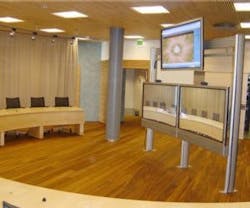Designing Telepresence Spaces
A short definition of “telepresence” for the uninitiated: It’s the closest thing to virtual reality for business meetings and distance learning (or “videoconferencing on steroids and acid,” depending on the age of the audience). A more formal definition: It’s a visual collaboration environment that addresses the human factors of participants, and attempts to replicate, as closely as possible, an in-person experience. Telepresence spaces are rooms, installations, and “experiences” built by companies like Cisco Systems Inc., Digital Video Enterprises, Musion, Polycom, TelePresence Tech, and Teliris, and are connected in real time to a similar site somewhere else in the world, where the remote participants are life-sized with fluid motion, accurate flesh tones, and superb acoustics. The result is an experience that feels like you’re sitting in the same room with someone on the other side of the globe, or watching a life-sized version of someone on stage.
The Digital Video Enterprises Telepresence Stage (view YouTube video)
The first thing that you need to know about creating unique telepresence environments is that it’s hard to create unique telepresence environments. Part of the magic of telepresence conferencing is that most telepresence systems create a “business-class consistency-of-quality” for intra-company and inter-company business. Unlike traditional videoconferencing systems, where virtually every deployment is different with respect to lighting, camera capture, acoustics, display, etc., the majority of telepresence systems create environments that mirror each other perfectly, which improves the illusion of being in the same physical space.
Creating a telepresence environment from off-the-shelf components might save some money for certain customers, but you’d lose some of the magic in communicating with other established, widely deployed telepresence systems. This doesn’t mean that there isn’t a market for creating unique telepresence environments, but, truth be told, it’s small (but growing). So, what’s the current market for unique telepresence solutions and environments, and how will architects and systems integrators participate?
Telepresence Group Systems
This is the overwhelming majority of the market. Telepresence group systems usually hold 6 to 18-plus participants who face 3 to 4 screens, a video wall, or an angled piece of mirrored glass called a “beam splitter.” Many systems will fit into a standard conference room, but some require make-ready, including moving air ducts whose noise may interfere with the acoustics in the room. For most corporations interested in deploying telepresence, the best time to take the plunge is when building new, renovating/upgrading existing facilities, and/or moving a facility. This is the time when the large cost of the telepresence system – and any make-ready – can be capitalized into the big spend for the new facility. Some installations require a custom design to accommodate uniquely shaped rooms or other requirements.
Pro-Modifying Existing Telepresence Systems
There are many potential improvements that can be made to existing telepresence systems, and many modular telepresence systems can be made better by improving the environments.
The Human Productivity Lab recently created a design for “Pro-Modifying” a Polycom RPX environment for a Fortune 25 energy company that creates a stand-up presentation environment with a podium in the RPX environment. The HPL design would allow an instructor to teach standing up and address local and remote sites “in the round,” sitting at the table and being conversant with the remote site, and/or standing at an interactive whiteboard. The design addressed a requirement from the client to replicate, as closely as possible, a traditional classroom setting for the continuing education of petrochemical professionals around the world.
In addition to the environment, systems integrators and pro-AV professionals can help with integrating enhanced collaborative tools like visualizers, interactive whiteboards, and streaming encoders/decoders for high-resolution images and AV content. Telepresence vendors, such as Telanetix and LifeSize Communications, sell the basics (multi-camera/codec, control, and display), creating an opportunity for architects and pro-AV professionals to address the lighting, acoustics, color, and any company branding in the environment.
Specialty Telepresence Spaces
Telepresence environments are escaping from the C-suite and beginning to be integrated into publicly available spaces. Tata Communications recently launched a network of publicly available telepresence systems in Tata Taj Hotels. Cisco recently built a proof-of-concept for a publicly available telepresence conferencing center in Santa Clara, CA. Expect publicly available telepresence to grow as the economy drives more airlines into the ground, making commercial air travel more expensive and less convenient while globalization continues.
Telepresence Installations
Telepresence is even appearing in outdoor installations. The Telectroscope delighted crowds from London and New York City who could interact with each other across the pond for several months.
While telepresence systems, applications, and experiences are relatively expensive today, virtually every component, including cameras, codecs, display technology, and bandwidth, is dropping in price.
As an industry, we look forward with eager anticipation to seeing what the architectural and pro-AV community creates with the growing palette of telepresence tools.
Howard S. Lichtman is president at the Ashburn, VA-based Human Productivity Lab, the world’s leading consultancy on telepresence, telepresence managed services, and telepresence inter-networking.
